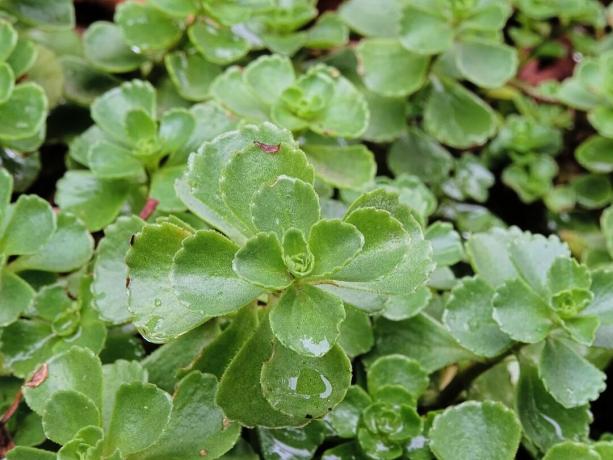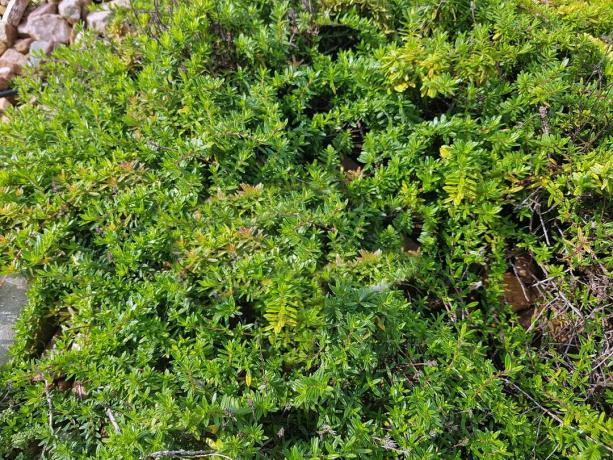Ground cover should usually cover areas as quickly and densely as possible. It is all the more important that the vigorous ground cover can withstand severe frosts.

Which gardener does not know the situation? The last weeding was only a week ago and the green tips of the annoying couch grass are already showing up again (Elymus) or the relentless bindweed (Convolvulus arvensis). Before the back suffers severe pain from further maintenance procedures, intelligent plants that densely cover the area can help. And here “ground cover” is the magic word. We introduce you to this article especially hardy plants with a ground-covering growth, which even after severe winters in your bed still tightly and effectively protect against unwanted bed dwellers.
contents
- Hardy ground cover: 5 particularly robust species
- Hardy ground cover: 5 particularly beautiful species
- Hardy ground cover: 5 particularly vigorous species
Hardy ground cover: 5 particularly robust species
In rougher areas, you should definitely use hardy plants that can cope well with difficult weather conditions. However, caution is advised when using the term “hardy”. The division usually takes place in winter zones, which cover a very large temperature range from Z11 (above +4.4 ° C) to Z1 (below -45 ° C). In addition, the winter hardiness can vary slightly depending on the region. In Germany you should choose plants with a winter hardiness of at least Z7 (about -15 ° C) for your garden. In the following we show you a selection of different particularly hardy plant genera and species, so that you can perhaps gain new, creative ideas for your bedding areas.
-
Pillow aster (Aster dumosus)
The pillow aster originally comes from North America, is extremely robust and not only beautiful to look at during flowering. The pillow aster owes its name to its cushion-like growth. It forms closed flower carpets very quickly and should therefore be cut back regularly.

-
Bergenia (Bergenia)
The evergreen Bergenien inspire all year round with colorful foliage and are also extremely hardy. In spring, the ornamental shrub flowers mostly in beautiful pink or red tones, depending on the variety. As a rule, bergenias are very easy to care for and do not even have to be pruned. -
Himalayan cranesbill (Geranium himalayense)
Plants of the genus Geranium are used in a variety of ways in the garden. The Himalayan cranesbill grows in its original home on alpine meadows of up to 4,440 meters and is therefore very robust. Down to -20 ° C doesn't bother him in winter. The bright blue flowers appear from May to June.

-
Upholstery phlox (Phlox subulata)
The ‘Emerald Cushion Blue’ variety is a specialty among the Phlox subulata-Species. It is coarser than its relatives in all parts and forms dense cushions of coarse-needle leaves that are very long-lived. In addition, the light, lavender-blue flowers from May to June are very nice to look at. -
Carpet Sedum (Sedum spurium)
This perennial is very suitable as a small, evergreen ground cover. Unfortunately, the carpet sedum rarely blooms. Originally this plant comes from rough areas in the Caucasus and the Middle East, so it can tolerate cooler and more humid conditions than most of the others Sedum-Species.

Hardy ground cover: 5 particularly beautiful species
In addition to their mere function of covering the ground, these plants can of course also aesthetically enchant your garden. The choice of scent notes, leaf positions, flower shapes and colors is almost immeasurable. We are now introducing you to the most beautiful winter hardy ground cover:
-
Blue bob hair (Pratia pedunculata)
This rapidly growing ground cover is native to New Zealand. It is characterized by its long flowering period from May to October. The small porcelain-blue flowers form dense mats. With us, the creeping cushion plant is usually hardy, but should be covered under certain circumstances to protect it from the winter sun.

-
Mock forest master (Phuopsis stylosa)
The mock forest master blooms beautifully in different shades of pink and red. The robust perennial is also very vigorous and forms real mats if it likes its location. The flowering period is from June to August. In this, the flowers and leaves also exude a wonderfully tart scent. -
Silver immortelle (Anaphalis triplinervis)
This attractive perennial with the small white flower heads is also known as a pearl basket. The Silberimmortelle only shows its flowers from August, but then into October. Due to its clump-like habit, it is also very suitable as a border or cut perennial.

-
Double daylily (Hemerocallis fulva)
One of the most beautiful perennials is the daylily. It is very easy to care for and can form an impressive eyrie over the years. You can now find varieties of daylilies in many different colors. In East Asia it is not only cultivated as an ornamental form, but is also used as a medicinal plant and in the kitchen. -
Carpet japan sedge (Carex morrowii foliosissima)
The Carpet Japan Sedge doesn't need magnificent flowers to look beautiful. The sour grass plant (Cyperaceae) also pleases with its long leaves with white-yellowish marginal stripes. The formation of runners quickly results in strong tillering, which contributes to weed suppression.

Hardy ground cover: 5 particularly vigorous species
Plants that have a high annual growth are suitable for particularly quick coverage of bedding areas. These do not have to be simply green, but can be a real feast for the eyes in the garden due to their leaf color or flower shape - especially when there are many plants next to each other. The following ground covers are particularly vigorous:
-
Cascade Thyme (Thymus longicaulis odoratus)
This type of thyme likes to grow dense and pillow-shaped over dry stone walls. From June to July the beautiful pink flowers appear and make the cascade thyme a real eye-catcher in the garden. The aromatic leaves are also used in the kitchen.

-
Wild aster (Aster ageratoides)
The wild asters are very diverse. The ‘Asran’ variety, for example, is relatively robust and broad-growing. The light purple flowers appear from August. The wild aster is also very drought-resistant and hardly needs any care. Short runners create large stocks very quickly. -
Blue mint (Nepeta sibirica)
The blue mint, also better known as grape catnip, spreads relatively quickly to form stocks. The purple-blue lip flowers open from June to July and then attract a variety of insects, such as bees and butterflies. NepetaSpecies are also very suitable as bed neighbors for roses.

Tip: A fertilization when planting - for example with sustainably produced Plantura organic flower fertilizer - promotes soil life in your garden. With further fertilization after flowering, you strengthen your blue mint and make it particularly robust.
-
Cypress Spurge (Euphorbia cyparissias)
The cypress milkweed is native even in our latitudes and spreads strongly over foothills. The small, lemon-yellow flowers also have an intense scent of honey. It prefers to grow in dry, lean locations where it can reach heights of up to 40 cm. However, caution is advised when handling the plant, as the milky sap that escapes can trigger unpleasant contact allergies. -
Chinese lantern flower (Physalis aklekengifranchetii)
The bright orange lanterns are an eye-catcher in every garden. If the perennial feels good, however, it spreads very strongly and can then become annoying. The poisonous nightshade plant should therefore be planted where the urge to spread does not interfere.

The plants presented here offer you many possibilities to aesthetically enhance the brown, bare areas in the bed. The interaction of this ground cover with other perennials is particularly worthwhile, as you can thus add blossom-free weeks or bring out their flowering even more. In addition to these advantages, the maintenance effort in the form of weeding can be significantly reduced with a closed plant cover. Caution is only required with very vigorous species, because they can very quickly become unpopular weeds in the wrong location.
For more information, go to edible ground cover inform in our special article.
